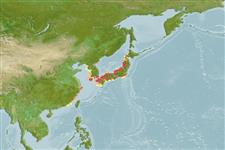Common names from other countries
Issue
Acanthogobius stigmothonus (Richardson, 1845) is considered as valid (from the South China Sea and Gulf of Tonkin) in Shibukawa & Iwata, 2013 (Ref. 93271).
Environment: milieu / climate zone / depth range / distribution range
Ecologia
marinhas; Água doce; estuarina demersal; anfídromo (Ref. 51243); intervalo de profundidade 1 - 6 m (Ref. 96339). Temperate; 52°N - 23°N, 116°E - 143°E
Northwest Pacific: Russian Far East (from Amur to Peter the Great Gulf), Korean Peninsula, Bohai Sea, Yellow Sea and East China Sea of China, and Hokkaido to Kyushu of Japan.
Length at first maturity / Tamanho / Peso / Idade
Maturity: Lm 27.0 range ? - ? cm
Max length : 30.0 cm TL macho/indeterminado; (Ref. 2850); common length : 14.5 cm TL macho/indeterminado; (Ref. 12193)
Inhabits muddy and sandy bottoms along the shore of bays and estuaries, sometimes ascends rivers. Intertidal to at least 6.5 m (Ref. 96339). Oviparous, spawn in winter to early spring (Ref. 205). Eggs are deposited in Y-shaped nests (Ref. 205). Used in Chinese medicine (Ref. 12166).
Eggs are deposited near the base of the Y-shaped nest (Ref. 51058).
Shibukawa, K. and A. Iwata, 2013. Review of the East Asian gobiid genus Chaeturichthhys (Teleostei: Perciformes: Gobioidei), with description of a new species. Bull. Nat. Mus. Nat. Sci. Ser. A., Suppl. 7:53-66. (Ref. 93271)
Categoria na Lista Vermelha da IUCN (Ref. 130435)
CITES (Ref. 128078)
Not Evaluated
Ameaça para o homem
Harmless
Utilização humana
Pescarias: espécies comerciais; Aquário: Aquários públicos
Ferramentas
Relatórios especiais
Descarregue XML
Fontes da internet
Estimates based on models
Preferred temperature (Ref.
115969): 12 - 21.6, mean 17.9 (based on 189 cells).
Phylogenetic diversity index (Ref.
82804): PD
50 = 0.5156 [Uniqueness, from 0.5 = low to 2.0 = high].
Bayesian length-weight: a=0.00692 (0.00373 - 0.01284), b=3.01 (2.85 - 3.17), in cm Total Length, based on LWR estimates for this species & (Sub)family-body (Ref.
93245).
Nível Trófico (Ref.
69278): 3.4 ±0.3 se; based on diet studies.
Resiliência (Ref.
120179): Médio, tempo mínimo de duplicação da população 1,4 - 4,4 anos (Preliminary K or Fecundity.).
Fishing Vulnerability (Ref.
59153): Low to moderate vulnerability (33 of 100).
